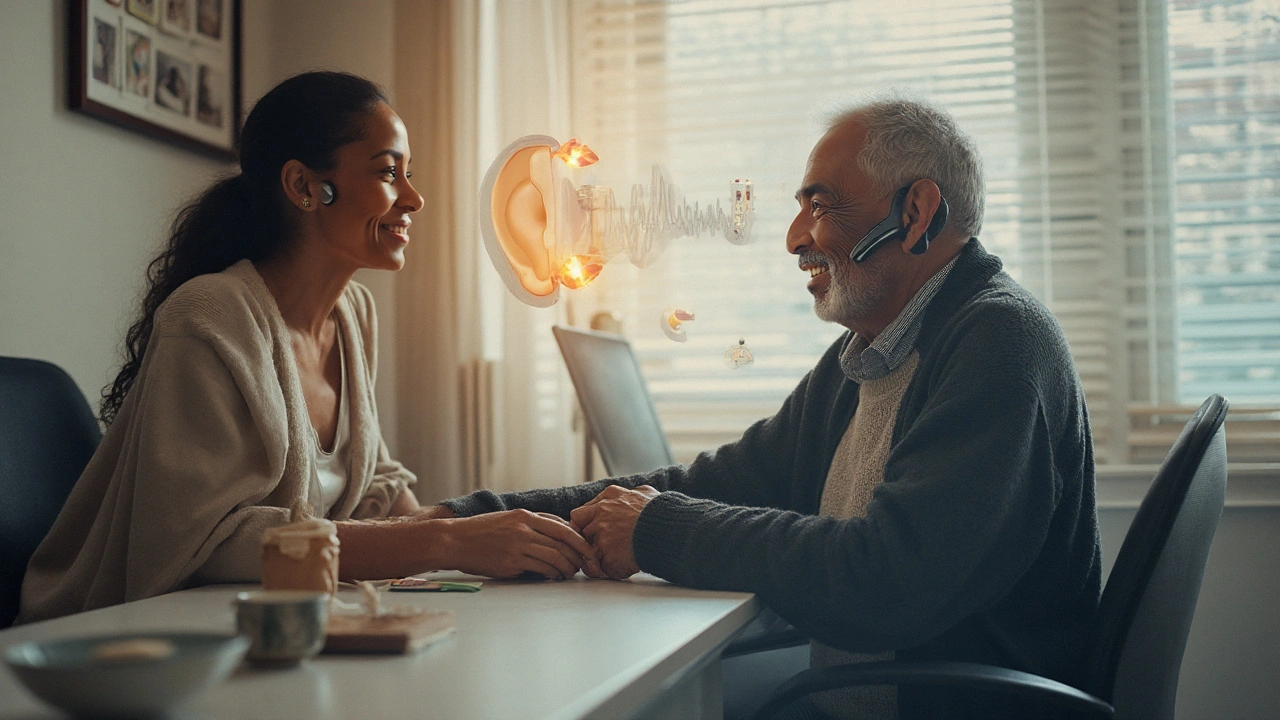
If you’re missing pieces of conversations, your brain may be working overtime to fill the gaps. That constant strain doesn’t just make you tired-it’s tied to faster memory and thinking problems over time. The science has shifted from “maybe” to “pay attention.” Here’s what the evidence says, where the limits are, and the concrete steps to protect your mind and your hearing starting today.
TL;DR
- Untreated hearing loss is one of the largest modifiable midlife dementia risks (Lancet Commission, 2020; 2024 update).
- People with hearing loss show higher rates of cognitive decline; hearing support can help, especially when started early.
- The ACHIEVE trial (Lancet, 2023) found hearing care slowed decline over 3 years in higher-risk older adults.
- First steps: notice the signs, get a hearing test, choose OTC or prescription hearing aids wisely, and reduce noise exposure.
- Stack the basics: move more, treat blood pressure, sleep well, stay socially engaged-these pull in the same direction for brain health.
Why hearing and thinking are linked (and what the data actually shows)
The short version: when hearing drops, the brain gets less clear input. You work harder to decode speech, and that steals mental bandwidth from memory and thinking. Over time, the auditory parts of your brain can thin, and social withdrawal can creep in-both linked with faster cognitive decline. This is the core bridge between hearing loss and cognitive decline.
Here are the big drivers researchers track:
- Cognitive load: If your brain spends extra effort decoding every sentence, less is left for remembering details and making decisions.
- Brain structure changes: Long-term hearing loss is associated with faster shrinkage in auditory and related brain regions on imaging studies.
- Social isolation: Hearing trouble nudges people away from group situations. The CDC has reported social isolation is linked with about a 50% increased risk of dementia.
- Shared risks: Vascular problems (high blood pressure, diabetes), smoking, and inflammation affect both hearing and brain health.
What about hard outcomes? In a well-known Johns Hopkins cohort (Lin and colleagues, early 2010s), adults with mild hearing loss had roughly double the dementia risk, moderate about triple, and severe about five times the risk compared with peers with normal hearing. That doesn’t mean hearing loss causes dementia on its own, but the association is strong and consistent across studies.
Is intervention helpful? The Lancet Commission (2020; 2024 update) ranks untreated midlife hearing loss among the largest modifiable risk factors for dementia, potentially accounting for a meaningful share of cases worldwide. The ACHIEVE trial (Lancet, 2023) tested a structured hearing intervention in older adults (ages 70-84). Over three years, the hearing group had a slower rate of cognitive decline in a predefined higher-risk subgroup (those with more health vulnerabilities). The overall sample showed a favorable trend but not a significant difference. The takeaway: hearing care seems to matter most if you’re at higher risk and probably works best when started before problems snowball.
Two more points for context:
- Observational studies: Multiple pooled analyses suggest people who use hearing aids have around a 15-20% lower risk of incident dementia versus non-users after adjusting for confounders. This is not proof of causation, but it aligns with the biological story.
- Age matters: Midlife hearing loss (40s-60s) appears especially important for later risk. Don’t wait for retirement to care about your ears.
| What the evidence says | Best source (year) | Estimated impact | Notes |
|---|---|---|---|
| Untreated midlife hearing loss is a major modifiable dementia risk | Lancet Commission (2020; 2024 update) | Contributes a meaningful share of dementia cases globally | Risk is population-level; individual risk varies with severity and other factors |
| Mild-severe hearing loss linked to higher dementia risk | Johns Hopkins cohort (2011-2013) | Approx. 2x (mild), 3x (moderate), 5x (severe) vs. normal hearing | Association; not proof of causation |
| Hearing intervention slowed decline in higher-risk older adults | ACHIEVE RCT, The Lancet (2023) | Slower cognitive decline over 3 years in predefined high-risk subgroup | Early, targeted intervention seems to help most |
| Hearing aid use and incident dementia | Pooled observational studies (2022-2024) | About 15-20% lower risk among users | Residual confounding possible; results consistent across cohorts |
| Social isolation connected to dementia risk | CDC/NIA syntheses (2020-2024) | ~50% higher risk reported in some cohorts | Hearing support can protect social engagement |
How to spot issues early (and get a clear diagnosis)
Early detection lets you protect your brain while hearing is easiest to help. If any of these sound familiar, it’s time to check your hearing:
- Conversations sound blurry or mumbled-especially in restaurants, meetings, or on Zoom.
- You need captions on most shows, or you avoid phone calls because they’re too hard.
- Family says you turn the TV up too loud, or you watch people’s lips to keep up.
- Ringing or buzzing (tinnitus), ear fullness, or you favor one ear.
Quick ways to screen yourself at home:
- Digits-in-noise tests: Free app/online tests play numbers in background noise and estimate how much signal you need to hear speech.
- Headphone-based pure-tone apps: Not a diagnosis, but good for “something’s up” vs “probably fine.”
- Reality check: Ask someone you trust whether you miss words in conversation or avoid group settings.
When to see a professional:
- Right away if you have sudden hearing loss (hours to days), ear pain, drainage, dizziness, or hearing loss in just one ear. Those need urgent medical evaluation.
- Soon if you consistently struggle in noise, rely on captions, or notice mental fatigue during conversations.
What a full hearing evaluation includes:
- History and ear exam: Rule out wax, infection, or eardrum issues.
- Audiogram: Beeps at different pitches show the softest sounds you can hear (measured in dB HL). Speech tests in quiet and noise measure real-world function.
- Discussion: You’ll review whether your pattern looks sensorineural (age/noise), conductive (often fixable), or mixed, and what supports make sense.
How to read your audiogram at a glance:
- Normal: 0-25 dB HL. Mild: 26-40. Moderate: 41-55. Moderately severe: 56-70. Severe-profound: 71+.
- Sloping losses (worse at high pitches) make speech clarity tough, especially in noise.
- Good speech scores in quiet but trouble in noise often respond well to hearing aids with noise management.
One more wrinkle: the U.S. Preventive Services Task Force has said evidence is insufficient to recommend universal screening for asymptomatic older adults. That’s a population-level statement, not a personal one. If you notice problems, don’t wait. Symptoms trump averages.

What actually helps (and where to start)
Think of hearing support as a package: technology + communication habits + lifestyle. The right mix lowers day-to-day strain and supports your brain.
Hearing aids: OTC vs. prescription
- OTC hearing aids (FDA category opened in 2022) are for adults with perceived mild to moderate hearing loss. They’re sold online and in stores, typically $300-$1,000 per pair. Good for straightforward needs, self-starters, and budget-sensitive buyers.
- Prescription hearing aids involve testing, fitting, and follow-up with an audiologist. Typical ranges: $2,000-$6,000 per pair depending on features and service bundles. Best for more complex loss, difficulty in noise, ear asymmetry, or when you want professional fine-tuning and counseling.
Which should you choose?
- Try OTC if your main issue is mild-to-moderate difficulty in noise, you hear okay in quiet, and you don’t have red flags (ear pain, drainage, sudden or one-sided loss).
- Go prescription if you have trouble even in quiet, big swings across pitches, one ear much worse than the other, or you tried OTC and still struggle.
Practical fitting tips:
- Start at comfortable volume and increase gradually over 2-4 weeks as your brain adapts.
- Use hearing aids all day. Only wearing them “when needed” forces constant re-adjustment.
- Turn on features that matter to you: directional mics for restaurants, Bluetooth for calls, volume buttons you can actually find with your fingers.
- Book adjustments. Fine-tuning speech-in-noise settings can be the difference between “meh” and “wow.”
Cochlear implants
If you still can’t understand speech with well-fit hearing aids, ask about an implant evaluation. For the right candidates, implants can restore access to speech clarity and reduce listening effort. Small studies suggest improvements in attention and memory measures after implantation, likely from reduced strain and fuller input.
Communication hacks that save brainpower
- Face people and ask for one voice at a time; sit with your back to the wall in noisy places.
- Use captions without guilt. They’re hearing’s reading glasses.
- Pair your phone to your aids. Direct streaming boosts clarity and drops fatigue.
- Learn “clear speech”: slightly slower, a touch louder, crisp consonants. Share that tip with family.
Noise: the hidden accelerant
- Headphones: follow the 60/60 rule-no more than 60% of max volume for 60 minutes at a time. If someone next to you can hear your music, it’s too loud.
- DIY protection: keep foam earplugs in your bag; wear them at concerts, games, or when using power tools.
- Home noise audit: soft furnishings, rugs, and curtains reduce echo so speech sounds cleaner.
Whole-brain backup plan
- Move most days: Aim for 150 minutes of moderate activity weekly. Blood flow helps both hearing and cognition.
- Treat blood pressure, diabetes, lipids: Vascular risks hit ears and brain.
- Prioritize sleep: 7-9 hours; get checked for sleep apnea if you snore or feel unrefreshed.
- Mood matters: Depression and anxiety worsen perceived hearing and cognitive performance. Treat them-it helps everything.
- Stay social: Hearing support is half the story; actually use it to rejoin the world.
Your action plan, checklists, and answers
Use this to move from “I think I’m missing words” to a calmer, clearer daily life.
Step-by-step plan
- Notice the pattern. Are you struggling mainly in noise, or also in quiet? Any red flags (sudden loss, pain, drainage, one-sided)?
- Screen at home. Do a digits-in-noise test with good headphones in a quiet room.
- Book a hearing evaluation. Ask for an audiogram, speech-in-noise testing, and a clear explanation of your results.
- Pick your starting device. OTC if mild-to-moderate and no red flags; prescription if complex or you want pro fitting.
- Commit to daily wear. Give your brain 2-4 weeks to adapt; set a reminder so you don’t “forget” them in a drawer.
- Tune your environment. Use captions, reduce echo at home, and choose seating that favors your better ear.
- Stack brain-healthy habits. Move, manage blood pressure and sugar, sleep, and stay social.
- Recheck yearly. Hearing changes; so should your settings. Bring real-life notes to your follow-up.
Quick decision guide: OTC or prescription?
- OTC now if: you hear okay in quiet; main struggle is restaurants/calls; no red flags; you’re comfortable adjusting tech.
- Prescription if: you struggle in quiet; speech sounds garbled; one ear is much worse; you have tinnitus that bothers you; or you tried OTC and still strain.
- Medical referral if: sudden drop, ear pain, drainage, dizziness, or one-sided loss. Don’t wait.
Checklist: signs your hearing support is working
- You follow group conversations without guessing every third word.
- You come home less mentally exhausted after social time.
- Family stops saying “You’re not listening.”
- You’ve reduced TV volume and don’t need captions for everything.
- Your calendar has more plans. You’re saying yes again.
Costs and coverage basics (U.S.)
- OTC hearing aids: roughly $300-$1,000 per pair.
- Prescription hearing aids with services: typically $2,000-$6,000 per pair depending on features and bundled care.
- Medicare (Original) doesn’t cover hearing aids; Medicare Advantage plans vary. Medicaid coverage varies by state. Veterans may have coverage through the VA if eligible. Check your specific plan.
Pitfalls to avoid
- Buying a device and not wearing it. Consistency is what helps your brain adapt.
- Ignoring background noise. Even great tech can’t beat a sports bar TV blaring at your back.
- Skipping follow-ups. Small adjustments unlock big gains.
- Waiting for “perfect” hearing. The goal is less effort and better connection, not superhuman ears.
Mini‑FAQ
- Will hearing aids prevent dementia? No device guarantees prevention. But reducing listening effort, preserving social engagement, and addressing a known modifiable risk can tilt the odds toward healthier aging.
- Am I too old to benefit? No. People in their 70s, 80s, and 90s report less strain, better mood, and more activity with proper hearing support.
- What if my hearing is “borderline”? If you notice strain, try support. Even low-amplification or situational devices (for TV, meetings) can help.
- Do brain games help? They can sharpen specific skills, but the bigger wins come from better hearing input, movement, sleep, and social engagement.
- Is tinnitus a dementia warning? Tinnitus is common with hearing loss and stress. On its own, it’s not a dementia signal. Still, get your hearing checked.
- How long until I feel a difference? Many notice less effort in 2-4 weeks of daily wear. Friends and family often notice first.
Next steps
- Today: Do a home digits-in-noise screen. Make a note of situations that drain you most.
- This week: Schedule a hearing evaluation. Add a daily walk and a fixed bedtime.
- This month: Start OTC or book a prescription fitting. Set two follow-ups for adjustments.
- This year: Annual recheck. Review your hearing goals and whether your tech still fits your life.
Troubleshooting for common scenarios
- “I can hear, but I can’t understand.” Ask for speech‑in‑noise testing and adjust directional microphones and noise reduction. Consider remote mic accessories for meetings.
- “My aids are too loud in restaurants.” Create a “restaurant” program with lower low‑frequency gain, stronger noise reduction, and narrower directionality. Sit with your back to the noise source.
- “My ears feel plugged.” You may need more open domes or venting. Check for wax. Gradually increase gain.
- “Phone calls still stink.” Turn on Bluetooth streaming, use mono-to-both‑ears setting, and add captions during calls if needed.
- “I’m overwhelmed by options.” Prioritize: comfort, clarity in noise, and easy controls. Fancy extras can wait.
If you take one idea from this: treat hearing like eyesight. The sooner you correct the blur, the less your brain has to fight, and the more life you get back.





Comments (8)
Ryan C
Let’s be clear: hearing loss isn’t just about missing punchlines-it’s a neurodegenerative red flag. The Lancet data is ironclad. Your auditory cortex atrophies like muscle without use, and that’s not metaphorical-it’s fMRI-proven. OTC aids? Fine for mild cases, but if you’re straining in quiet, you’re already in the danger zone. Don’t wait for ‘perfect’ hearing. Your brain doesn’t care about your budget-it just needs input. Start today. No excuses.
Also: Bluetooth streaming isn’t a luxury. It’s neuroprotection. 🎧🧠
Dan Rua
I get what you're saying, and I appreciate the science. My dad got hearing aids at 68 after years of turning up the TV, and it changed everything-he started joining family dinners again. It wasn’t magic, but it was real. The social piece matters as much as the tech. I’d add: don’t feel weird about using captions. They’re not a crutch; they’re a bridge. 👍
Mqondisi Gumede
So now we’re told our ears are failing because capitalism won’t pay for hearing aids and the government won’t screen us but we’re supposed to fix our brains with $5000 devices and walk 150 mins a week like some wellness cult member? LOL. I’ve been deaf in one ear since 1998 and I’m still alive and smarter than half the people in this thread. You think your audiogram defines your worth? You think the brain is a battery that drains? That’s not science-that’s corporate wellness propaganda. I listen with my eyes and my mind. You can’t measure that in dB HL. 🤷♂️
Douglas Fisher
...I just want to say, thank you. This post... it’s so important. I didn’t realize how much mental exhaustion I was carrying until I started wearing aids daily. The silence between words? It used to feel heavy. Now? It’s just... quiet. And I can breathe again. I didn’t know I was withdrawing until I wasn’t. I’m not saying this to be dramatic-I’m saying it because someone else might be sitting there, tired, thinking they’re just ‘getting old.’ You’re not. You’re just unheard. And that’s fixable. 💛
Albert Guasch
It is imperative to underscore the epidemiological significance of midlife auditory intervention as a primary preventive modality against cognitive deterioration. The ACHIEVE trial, while demonstrating subgroup efficacy, affirms a biologically plausible mechanism wherein reduced sensory input precipitates cortical reorganization and diminished neural reserve. Therefore, the integration of audiological rehabilitation into routine geriatric care protocols constitutes a cost-effective, population-level health imperative. Concurrent optimization of vascular health parameters further synergizes neuroprotective outcomes. Early, consistent, and professionally calibrated amplification is not merely assistive-it is neurologically restorative. We must elevate this discourse beyond consumer electronics and into the realm of preventive medicine.
Ginger Henderson
Okay but… have you ever tried just yelling louder? I mean, I’ve been telling my husband for years that he needs hearing aids, and he just says ‘I hear fine, you’re just quiet.’ So I started screaming. Now he hears me. Problem solved. 🙃
Bethany Buckley
How ironic that we’re being sold ‘hearing aids’ as cognitive salvation while the very architecture of modern life-constant noise pollution, algorithmic overstimulation, and the commodification of attention-erodes our capacity for deep listening. You want to prevent dementia? Stop optimizing for efficiency. Sit in silence. Read a book without a screen. Let your ears rest. The real crisis isn’t sensorineural loss-it’s the death of attention. Hearing aids are a Band-Aid on a severed artery. 🌿👁️🗨️
Stephanie Deschenes
For anyone reading this and thinking ‘I’m not ready’-you don’t have to be ready. You just have to start. Even if you only wear your aids for an hour a day at first. Even if you use captions while watching Netflix. Even if you just ask your partner to face you when they talk. Small steps rebuild neural pathways. You’re not failing-you’re healing. And you’re not alone.
Also: if you’re in the U.S., check out the Hearing Loss Association of America. They have free peer support groups. No judgment. Just people who get it.